PART 4
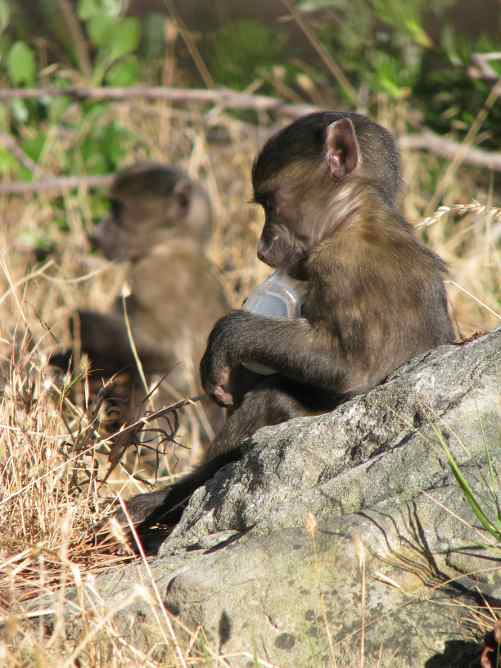
Two young baboons sit near residential area as one holds an empty plastic container. By classifying baboons as "repeat raiders", the legally protected Cape Chacma baboons are now essentially defined as "damage-causing animals", problem animals, - the same status as in other parts of the country where they are killed with impunity for raiding.
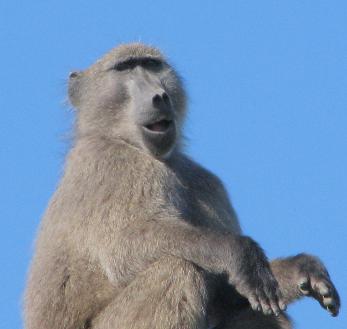
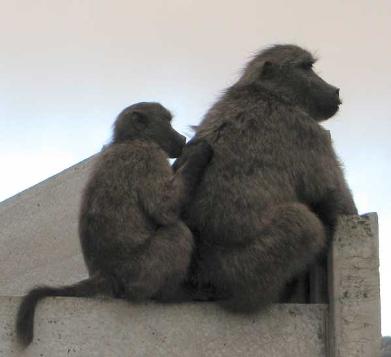
Sub adult male in urban area as juvenile female grooms adult female as she sits on fence.
While on the one hand the baboons have been praised in the past by stakeholders and decision makers as a "major asset of Cape Town", not "highly dangerous to man" and "a popular tourist attraction", some of the strategies adopted appear to threaten their well-being both in the short and long term.
With such a small population to begin with, one which has shown little change from around estimates of 350 for a decade, there is no room for error and experimentation with the iconic mammal most associated with the Cape Peninsula and a highlight of tourists' visit to Cape Town.
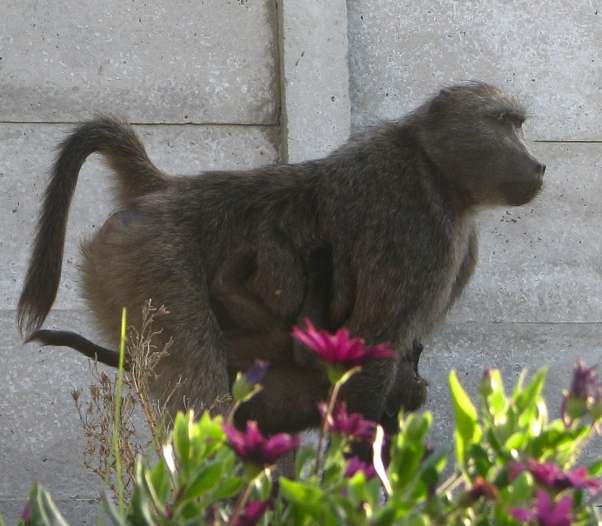
Female stands with baby underbelly in residential area. Though tolerated or enjoyed by many people, the Chacma baboons are often misunderstood and maligned. They are highly intelligent and affectionate with strong social bonds.
If a baboon does enter a house, residents are advised to stay calm and make sure it has an exit route. Banging on pots or shouting can help hasten its exit. Baboons are after food, they are not seeking confrontation or contact with humans.
Do not attempt to confront it or take away food as it will try to hold onto the food.
Do not make eye contact with the baboon, seen as a sign of aggression by primates.
Some people spray water on an outside window behind the baboon to coax it out. If residents do not want baboons on their outside property they are advised to chase them off using a strong jet of water from the hose.
Feeding of baboons by tourists also teaches them that food is available from humans and they may even try and grab it from them.
Never attempt to grab something back from a baboon as it will hold on to it. If inedible, after examining the item, it will drop it.

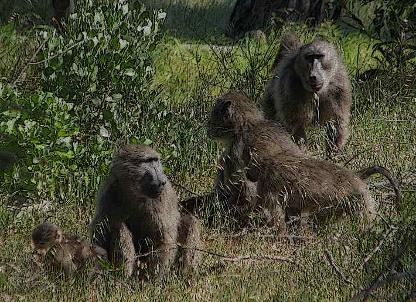


Baboons in an area designated as their home range. Given the Peninsula layout, where baboons' home ranges may adjoin urban areas, it is impossible for them not to come into urban areas on occasion, just one reason the protocol which seeks to ban them totally from urban areas - and potentially allows for culling if they enter property where people are - appears impractical and biased against the baboons.
Where necessary, revised management strategies are needed that take into consideration both residents' and baboons' interests as some of the current strategies are unrealistic and even scientifically flawed while heavily biased against baboons.
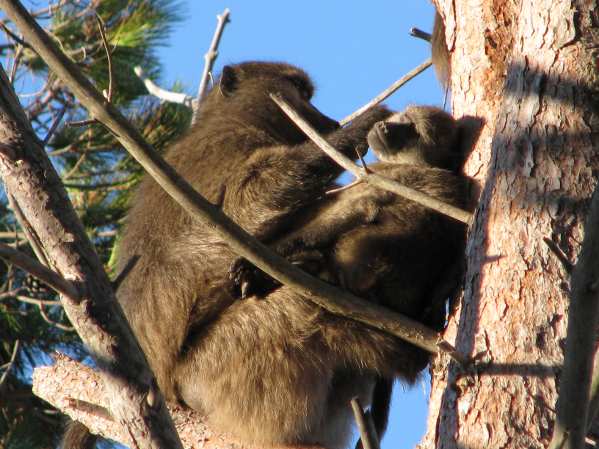

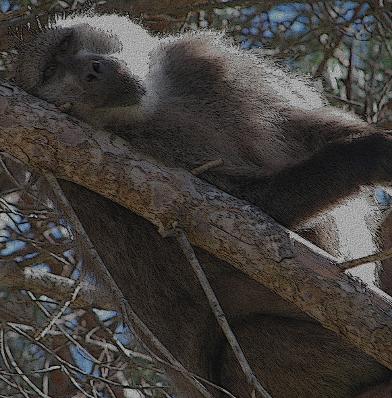
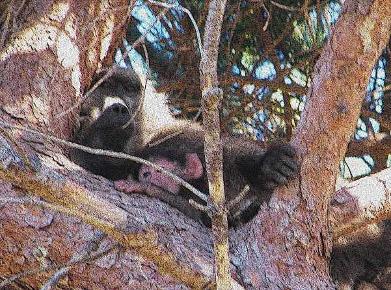
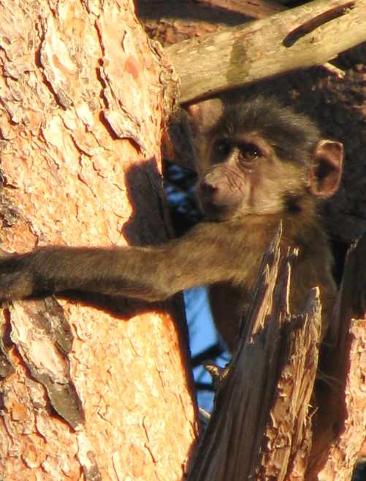
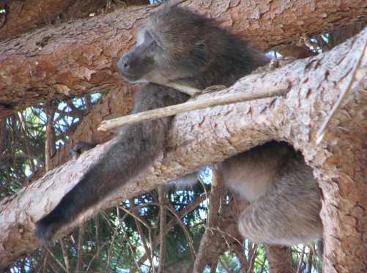
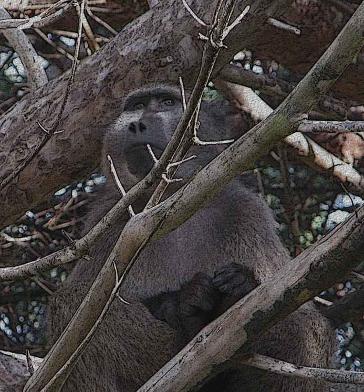
Baboons in pine trees - food source, sleep site and protection. One of the scientific recommendations made at the baboon expert workshop by BRU was for reduction of growth including alien vegetation such as pines.
Many people, locally and internationally became extremely concerned about the future of the Peninsula baboons, after management changes and strategies were made made since July 2009, backed up with scientific recommendations criticized by independent scientists, primatologists and experts.
Rather than using only a closed source of scientific input, advice from independent scientists, primatologists and baboon experts should be sought to ensure decisions are made in the best interests of the increasingly endangered Peninsula baboons.
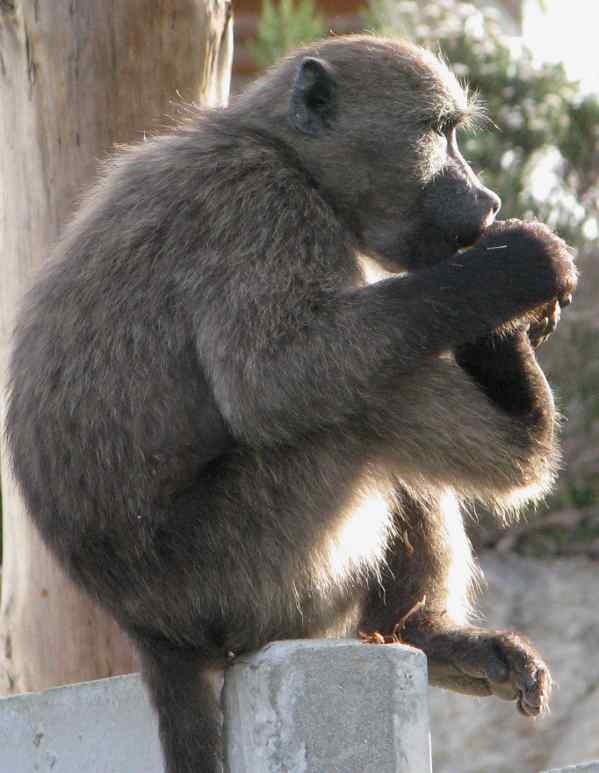
Juvenile baboon sits on fence cracking open a pine cone.
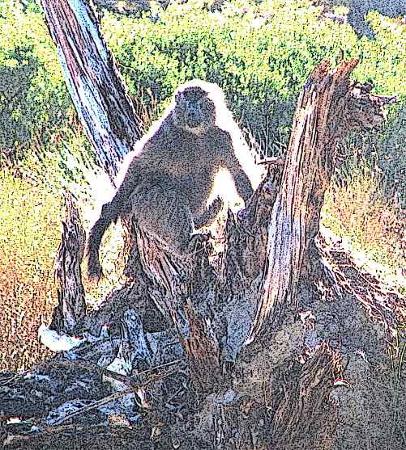

Female baboon sits on a log before being captured by Baboon Matters for veterinary treatment on suspicion of poisoning. Typical of many of the Peninsula baboons, she was found by the vet to have multiple projectiles in her body as well as a bullet at the base of her tail. (She was often seen turning and holding her tail, probably in pain.)
Nosketi, the adult male baboon was shot with a .22 pistol in a residential area. He had been shot on another occasion when vets found he had a fractured femur. He had multiple projectiles in his body, as do other baboons. The same baboons are often attacked on a number of occasions. Baboon Matters received numerous calls each year regarding injured baboons. Nosketi was put down on 11 November, 2011 after a resident shot him in the back while in the neighbour's garden, claiming self defense in view of the monitors. He was found to have around 100 projectiles, including pellets and shot, in his body.
Although ostensibly protected by law with stiff penalties, virtually no prosecutions have been effected in the past and lack of law enforcement and lack of education has been seen as encouraging residents to act against baboons.
Some currently opposing baboon presence move into the area, even from out of province or out of country, then find they are not prepared to make some adjustments, suffer raids and then call for baboons to be removed or attempt to "remove" them themselves. Some find not only baboons a "nuisance" but other forms of wildlife such as guinea fowl.
Nosketi, adult male baboon with blue paint from paintball gun. Paintballs can cause injuries including to eyes. Nosketi was shot in November 2001 by a resident who shot him in the back in the neighbour's garden, paralyzing him. He was put down later that day. He was found to have about 100 projectiles in his body.
Some residents excuse their pointing pellet guns, by saying the guns are not loaded and it makes the baboons run away - yet the number of baboons riddled with pellets show that these guns are being used. Hurting baboons does not prevent raids nor does it act as a warning to troop members if one baboon is hurt or killed.
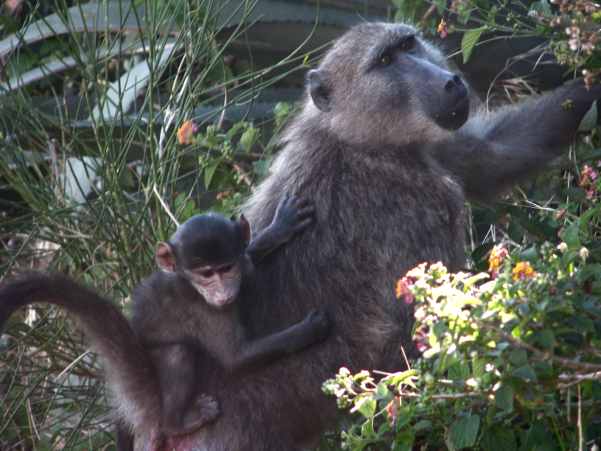
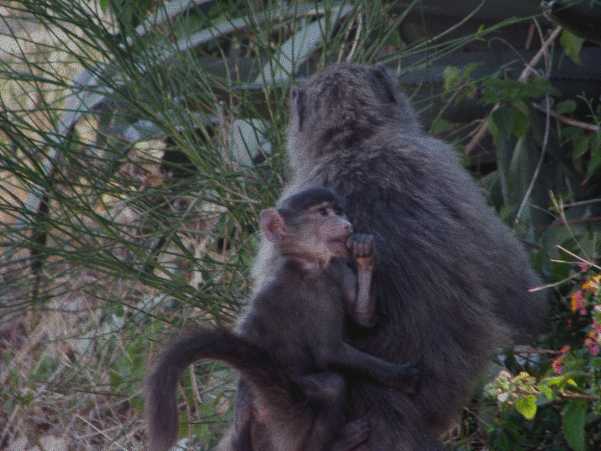
Female with baby on her back eats berries from bush in residential area.
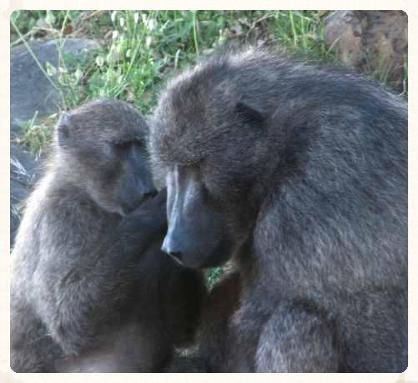

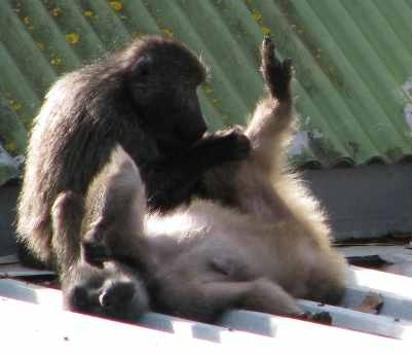
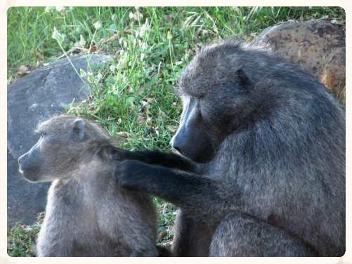
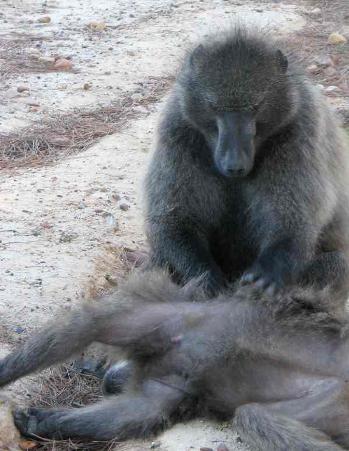
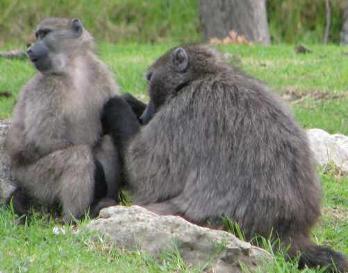
First column shows adult females grooming, second column males grooming.
Funding has been an ongoing issue for the monitoring program over the years. After a government poverty relief program ended in September 2008, baboon management was in a state of crisis due to lack of funding, with CapeNature and SanParks not seeing funding as part of their mandate and only the City supplying a portion.
Consequently there was not enough funding to supply monitors for all troops. During this period of a lack of funding for monitors, some residents in Simonstown who wanted baboons totally removed from the urban area, in consultation with the baboon research unit who oversaw the "Simonstown experiment", launched their own initiative using bullwhips and bearbangers to "chase" the baboons from the area. The influence of the STCA, BLG and BRU sharing goals of total removal of baboons from urban areas seems to be taking baboon management in a different connection that has many people concerned about the baboons' future.
While calling on CapeNature and SANParks to also contribute financially, the City has paid for a monitoring contract from October 2010 until mid 2012.
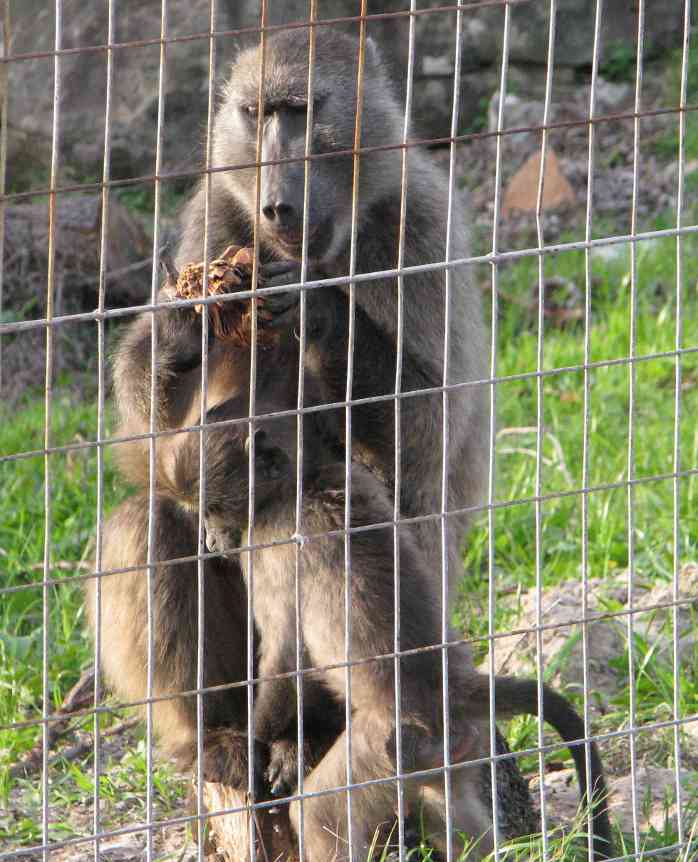
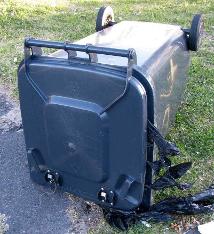

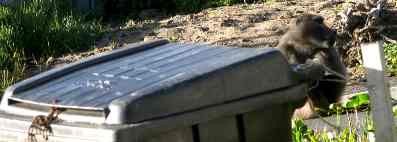
Baboons are opportunistic feeders and will eat available food. Bins need to be properly secured, so baboons cannot open them or drag contents through sides of bins. Additional security has been necessary on the double lock bins (centre). The bin (right) is seen locked and tied to an upright pole preventing baboons knocking it over and raiding.
Raids are avoided by residents effectively locking their bins and using security doors and window barring of 8cm or less. This has allowed some to live for many years without negative encounters.
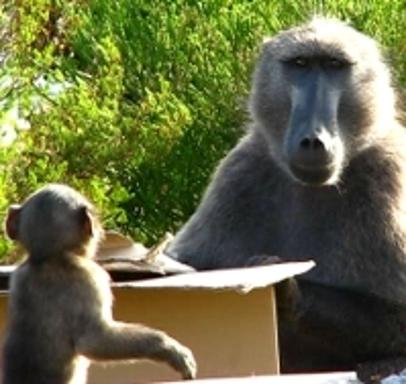
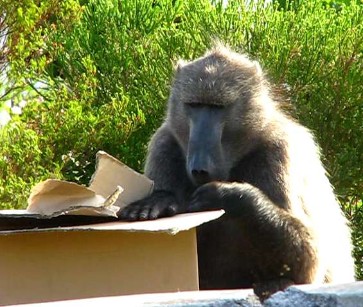
An adult male baboon "lipsmacks" as young baboon approaches. Lipsmacking is seen as a friendly, reassuring gesture among baboons. The male then returns to examining an empty cardboard box.
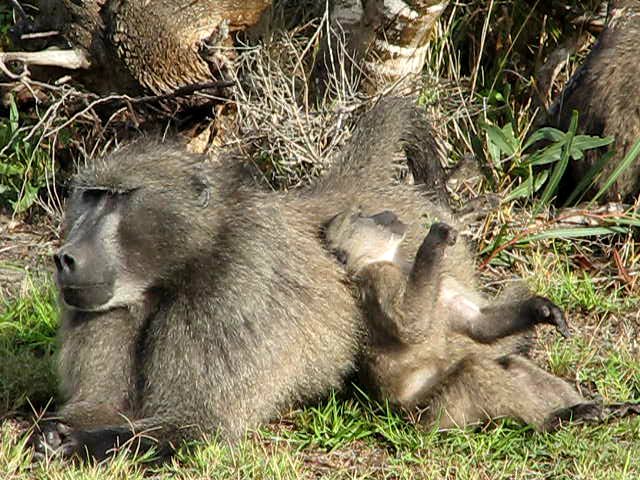
Male baboon with youngster showing the relaxed and tolerant attitude of males towards the young. In an attempt to put pressure on authorities to remove baboons, some residents promoted the idea that baboons are "increasingly aggressive" and pose a potential threat to humans and that their raiding behaviour is new, rather than having existed since the Cape was colonized.
In early 2011, the service provider NCC, began claiming that baboons were acting "aggressively" to monitors and field managers, however lack of monitor training and unnecessary use of aggressive handling techniques have been seen as contributing factors. The head of BRU stated on Carte Blanche TV program that baboons were "remarkably un-dangerous", around the time of change in management in 2009.
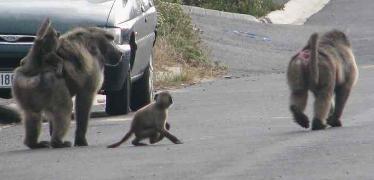
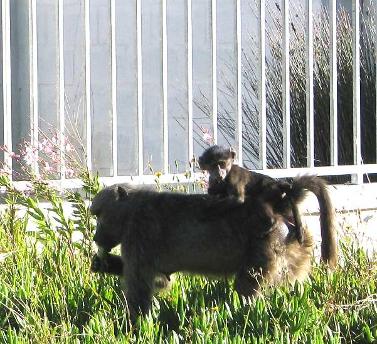
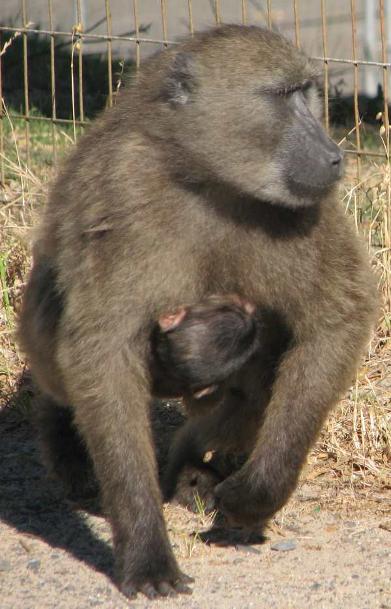
Baby rides on male baboon's back in road and baby sits on female in residential area while female carries baby underbelly. Baboons in some residential suburbs are riddled with pellets. Some residents mistakenly think they can hurt the animals - an action that is contrary to several laws including that of animal protection and anti-cruelty laws.
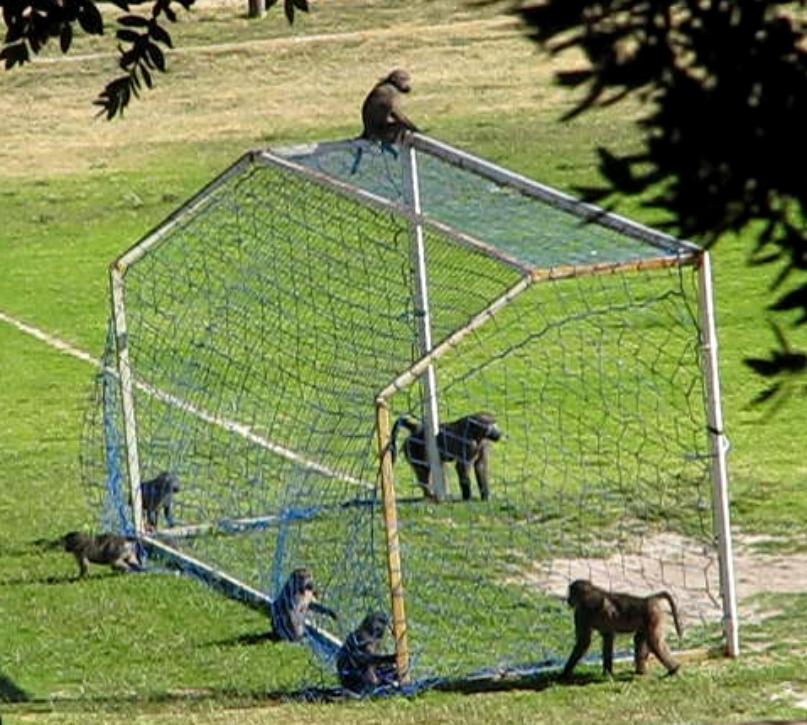
Baboons playing on a soccer field in an urban area. Many residents (and tourists) enjoy watching the entertaining baboons and do not mind them occasionally passing through the area, particularly if they take steps to effectively baboon-proof and therefore do not experience raids.
However, those opposing baboon presence can be extremely vocal regarding baboons, agitating for their removal. Often they fail to take effective steps to eliminate raids which would help solve their problems with the baboons.
At the baboon expert workshop one suggestion was that people should acknowledge they were moving into a baboon frequented area, prior to doing so. Sometimes estate agents fail to inform prospective residents what is involved in living in a baboon frequented area. Some people may be unaware of the presence of wildlife in the area before moving in or what baboon-proofing entails and may find their particular lifestyle would be better served living elsewhere. Other people regard the baboons as a feature of the area, some even moving specifically into the area for this reason.
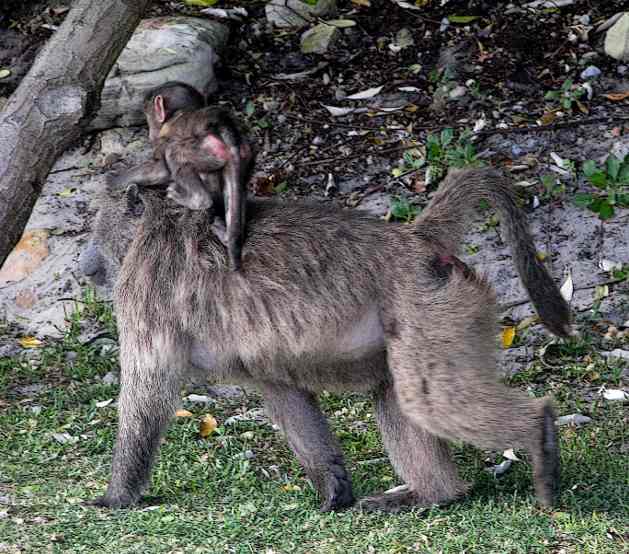
Baboon babies start out riding underbelly and later progress to riding jockey style on the mother's back. This infant holding onto the mother's head appears to be still refining its skills.
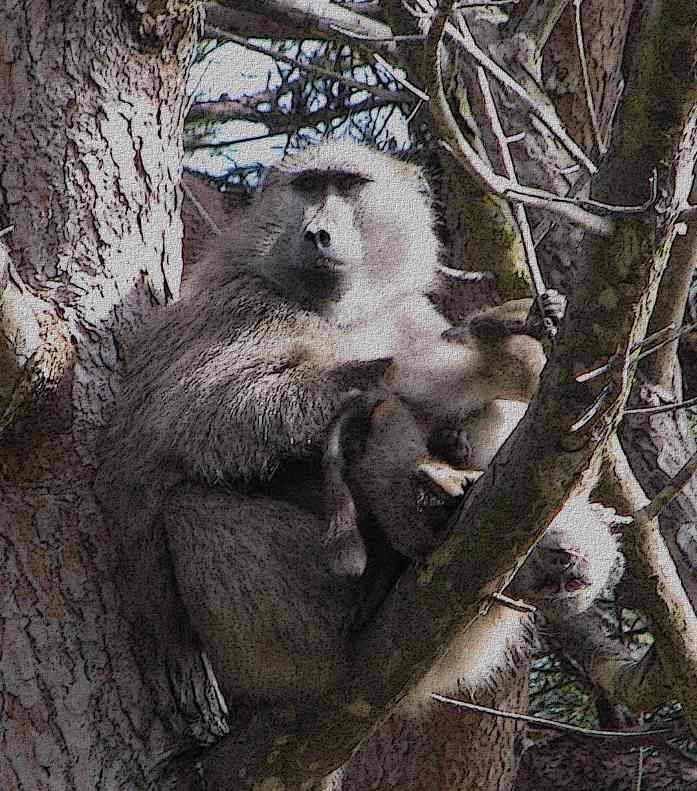
Female
and youngster in tree. In 2009 it was reported in the newspaper that a resident wrote to CapeNature asking if baboons could be shot "in
self-defense" claiming they could not be controlled with the
recommended jet of hose water. This may have
been her subjective
experience but is not true of other residents' experiences. She was
quoted then in the media as saying "one suggestion is to
relocate or cull the more aggressive males".
She
subsequently
became involved in a resident initiative, supported and endorsed by BRU, to “chase” baboons out
the Simonstown area using bullwhips and bear bangers, described by the SPCA CEO
as a “Neanderthal” technique when later attempting to introduce into other troops by
new monitoring management.
The difference since her first allegations is now the culling protocols are in place which place the baboons in greater danger than ever, particularly if the City enforces its mandate of safety and security with regard to the allegations made against the baboons acting "aggressively" or causing "trauma" or if eartagged baboons are deemed as repeat raiders.
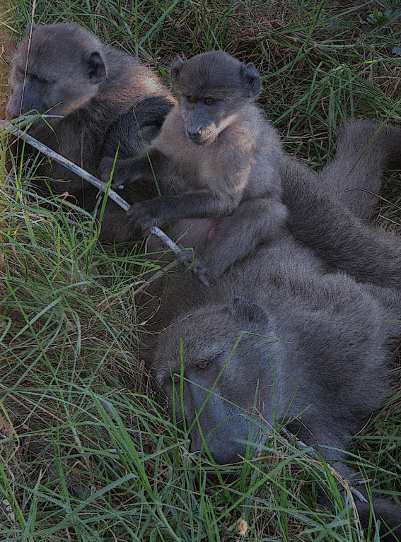
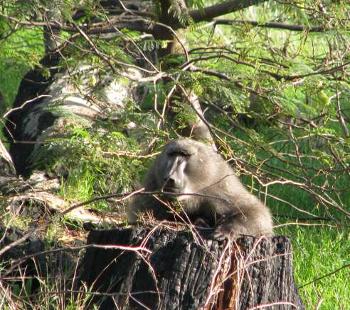
Juvenile with stick sits on top of sub adult male while adult male holds down a stick. Shortly before the photo was taken a monitor threw his herding stick at the adult male, narrowly missing him. Monitors have not received sufficient or proper training in the methods that work in herding baboons which is the responsibility of management. When the new service provider took over, the number of monitoring staff was more than doubled from 28 to around 60.
The humane methods that were taught to monitors by the previous service provider of assertive whistles, shouts, and a particular vocalisation enabled monitors to properly herd the animals. They were taught to treat the adult males, the leaders of the troop, assertively when necessary to establish dominance, but with respect rather than provoking aggression or teasing and bewildering them.
Regrettably these methods were either not emphasized, nor taught by the new service provider and were even ridiculed by the head of BRU as "failing". The only reason they were "failing", was because they were faling to be used sufficiently or at all.
Jenni Trethowan of Baboon Matters began her involvement with baboons after a local Kommetjie troop of 18 baboons was shot in 1990 by CapeNature Conservation (now CapeNature). She established Baboon Matters, running the monitoring service and training monitors over the last years, receiving international recognition for her work.
However, since mid 2009, her contribution and participation has been increasingly diminished and sidelined. In 2010 she had offered to help train the monitors, however was not taken up on this, although one director of NCC did express willingness to use her help if they got the long term contract which they did later in the year. Her permit to transport injured animals was revoked in 2009 by CapeNature and the popular Walking with baboons tours began to be curtailed in 2010 by SANParks on land it claimed as theirs, with the walks terminated in early 2011.
Disappointingly, NCC had still not approached Baboon Matters for help in training staff by the time Fred, leader of the Smitswinkel troop was culled in March 2011 ostensibly due to his ability (shared by others) to open car doors and raid and allegations that he was aggressive including to monitors and field staff who tried to prevent him raiding. (It is of note that Dr O'Riain of Bru stated that Fred had only become "aggressive" in the last year.)
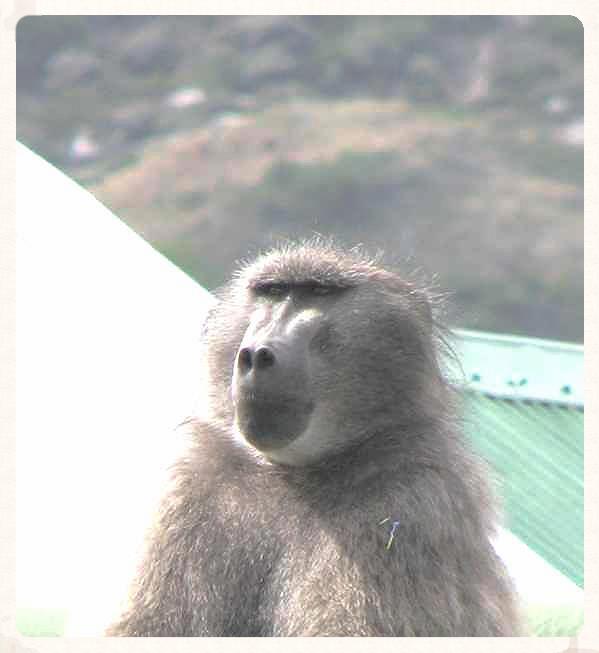
Adult male baboon, Nosketi, who was shot in the back by a resident. Monitors and field manager were in the area. He claimed self-defense. Nosketi was paralysed and put down later that day. He had survived 2 bullets and 100 pellets.
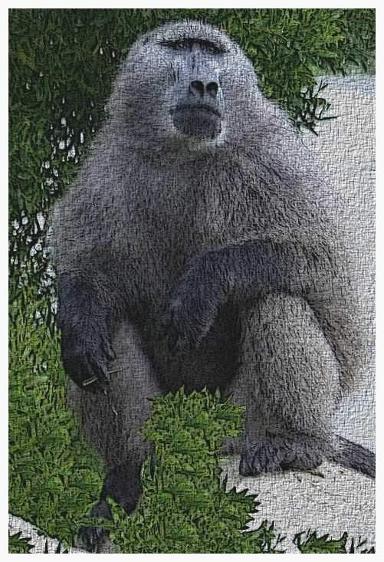

Alpha male and, adult female. Baboons play a role in seed dispersal of fynbos, part of the famous Cape floral kingdom that includes proteas and ericas.
Predominantly vegetarian, their natural diet consists of flowers, leaves, roots, bulbs, insects, scorpions etc. Troops on the coast also eat shellfish.
The chacma baboon is called "papio ursinus" - i.e. baboon resembling a bear, which may be noticeable in the appearance around the head and neck of mature males. While they may be opportunistic feeders like bears, baboons are not bears, neither do they predate on man, exhibiting remarkable control in dealing with provocation by humans and dogs, of whom they are often the victims. George, above, was killed by two dogs. (Adult males weigh up to 30-40kg, with females smaller at 15-20 kg and juveniles much smaller.)
Some residents continue to seek to portray them as a great threat to human safety in order to exert pressure on authorities to take drastic action such as culling. The research unit responsible for a number of the recommendations sought to justify culling/removing by saying a health threat exists through cross-transmission of pathogens even though in the past they have admitted there is no evidence for this. (In April 2011, they began eartagging some baboons for continuing research into this area.)
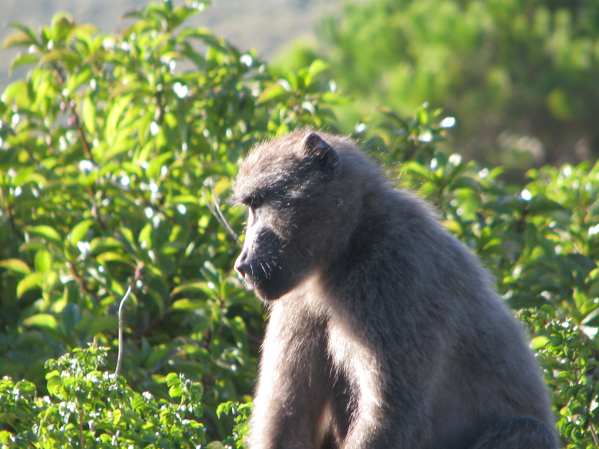
Juvenile baboon. Male baboons are fully mature at around the age of approximately 7 or 8, females around 5 or 6 years.
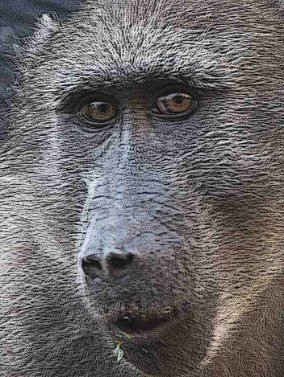
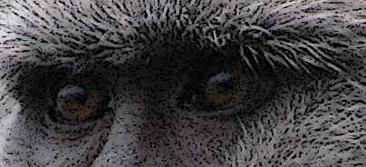

A sub adult male and mature females. While females reach maturity from 5, male baboons are still adolescents until a couple of years later. For primates, observe rules such as not staring directly into their eyes which can be seen by them as a sign of aggressive threat behaviour.
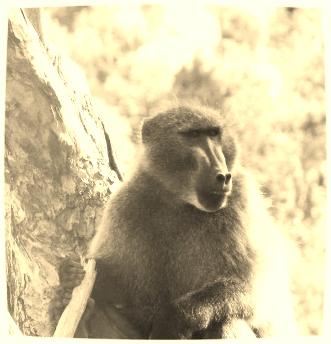
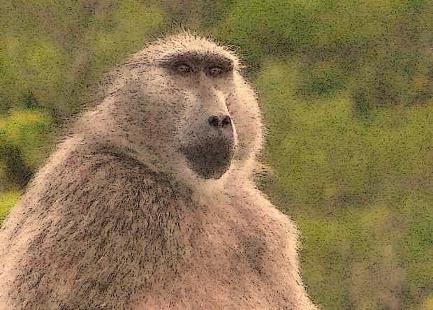
Adult male and female baboon. Females are sometimes mistaken as males by residents even though at 15-20 kg they are half the size of males.
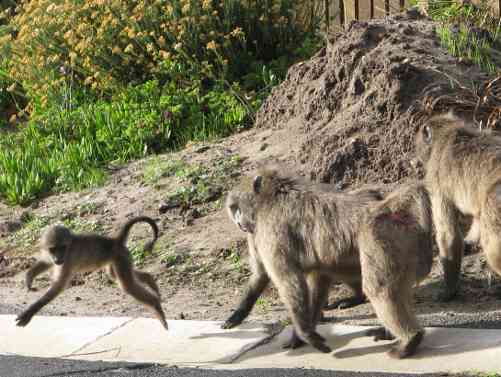
Small baboon leaps ahead of adults walking down the street.
Alpha male tagged and wearing a collar that can track his raiding pattern sits with females and babies on rocks. Eartagging is part of the first capture of dispersing males and repeat raiders, collaring can occur on second or third capture, relocation to a new troop on third capture. Culling can occur from second to fourth and final capture.
The female on the right is one of a number tagged in terms of a disease screening program which again raises concerns as when the first male Bart, was tagged in terms of the protocols, potential cross transmission of diseases between humans and baboons was given as a reason to cull Bart.

Alpha male with young baboon. What will happen to the Peninsula's already endangered baboons?
In July 2009, following a baboon expert workshop on the 2nd hosted by the City and CapeNature, amidst allegations of a flawed process, the monitoring contract was awarded away from long-time service provider Baboon Matters who helped institute and run the program to a new service provider following input from a research unit and the conservation authority.
In August 2009 an action plan was adopted (opposed by Baboon Matters amongst others) whereby dispersing males and repeat raiders could be culled. In 2009 ahead of the workshop some sought to put pressure on the authorities to remove baboons totally from urban areas, and continue to do so in 2010.
An interim contract was awarded in July 2009 and again in January 2010 and a long term October 2010-June 2012 contract to a conservation corporation whose manager was previously employed as nature conservation manager by the City under a previous administration in 2002 when he was quoted as saying: "As a conservationist I will not be involved in killing baboons. If we compromise on baboons, then where do we stop?"
The compromise began with the first protocol which targeted young, healthy males for culling.
In June 2010 another protocol was accepted targeting "individual raiding baboons", thereby targeting more than the dispersing males and confirming that the baboons' protected status was effectively no longer applicable as all baboons will raid given the opportunity of available food.
On 2 July, 2010, the anniversary of the workshop, the first baboon, alpha William, was killed without residents' knowledge, even though they had seen him being trapped and taken away for culling causing concern for the future of the animals amongst people around the world.
On 25 March Fred Alpha of the Smitswinkel troop was killed with residents trying to prevent it from happening (a press release was published on the day of his death that it was planned to trap him) while residents learned after their culling that Jimmy and Oswald (TK8) had been killed, battling afterwards to get official confirmation and details of this.
So, with the legal protection in effect removed by means of the protocols, who will protect the Peninsula's baboons and what will happen to the Peninsula's remaining Chacma baboons, long targeted by their human neighbours?
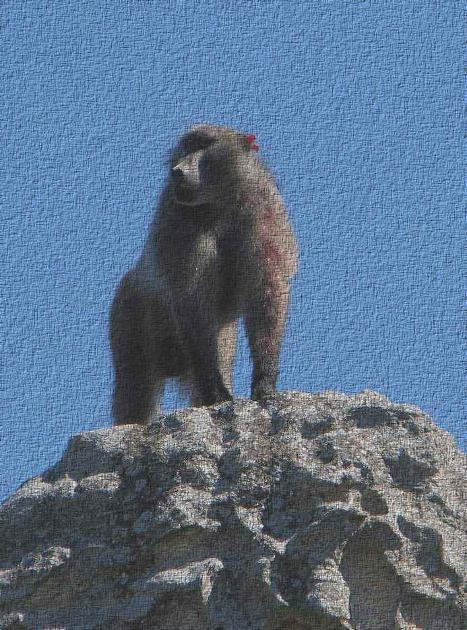
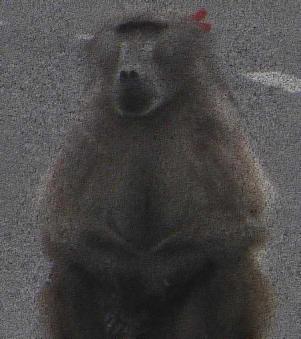
Anele, one of the dispersing males with an ear tag, the first step in the culling protocols. He was ridden over and killed. He was son of the Peninsula's oldest baboon, Eric. Once the two went on an extended walk visiting several of the Peninsula's seaside towns before returning back home, an experience that could now be considered a reason to place them on the list for culling.
His father was savagely attacked on dogs in 2008 and 2009. One firm baked him a carrot cake he had been known to help himself to on occasion, after the first attack. It was claimed this helped him make a more rapid recovery. Eric disappeared in November 2011.
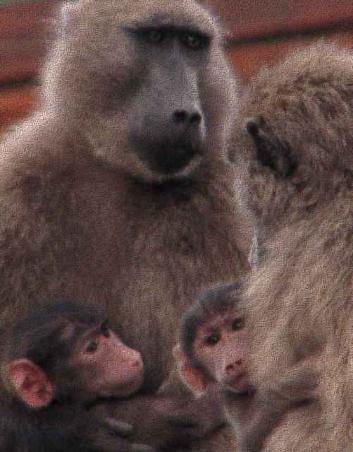
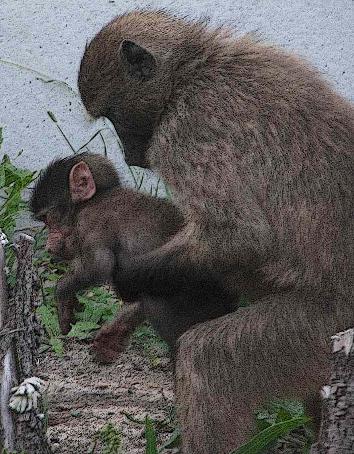


Baby baboons sit with adult females and a juvenile baboon picking up a baby. Many
residents enjoy watching the interaction between troop members.
Others shoot, whip, stone or set their dogs on them.
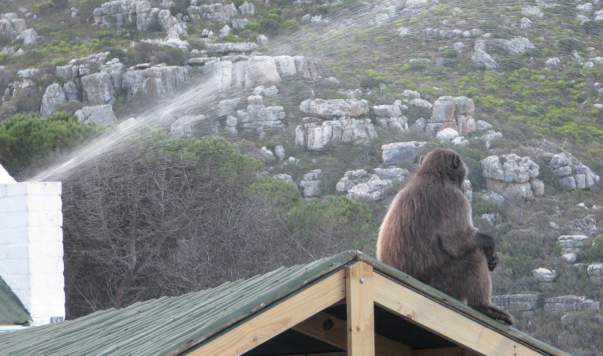
Male baboon sits on roof unaware of spray of hose water about to reach him. Chasing baboons off property with a strong jet of water is the recommended and humane way of removing them from the property.

A young baboon, one of the remaining baboons on the Peninsula sits in front of a discarded shoe - some are concerned the baboons may be in danger of also being "removed", giving the first dispersing male protocol and the extensive criteria of the new individual raiders protocol of 18 June, 2010.
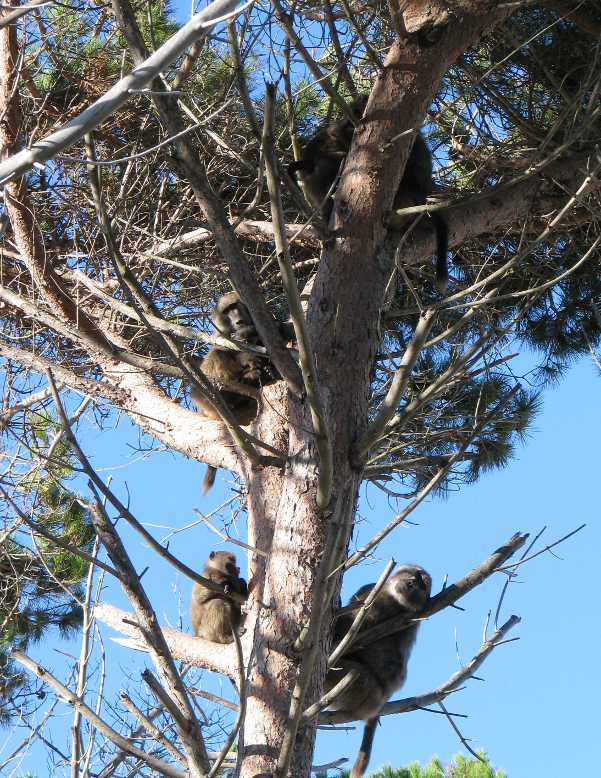
Baboons have their favourite sleep sites, high up in a pine tree like this or high on the rocks. Such sites are near to water which baboons usually drink on a daily basis. Led by the Alpha male, they can travel several kilometres a day, eating natural vegetation. They rise at dawn and settle to sleep as it becomes dark.
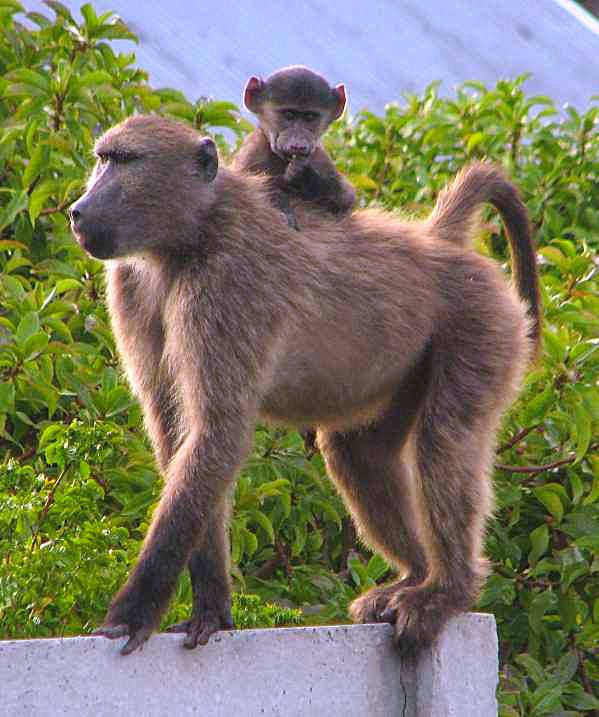
Female with baby stands on vibracrete fence. Although conflict situations can be avoided by taking the correct precautions, especially by not making food available either deliberately or inadvertently, attempts were made by some in residential areas known to oppose baboons to portray baboons as increasingly aggressive and a potential threat to human safety to motivate authorities to take action against them.
Instead of taking precautions necessary to avoid raids - or else choosing not to live in areas where free-ranging wildlife are part of the natural attractions for others - certain lobbies have long called for the total removal of baboons from urban areas and also attempted to "remove" baboons themselves using their own "tools".
As urban development actually cuts into baboon home ranges in a number of instances, it is unrealistic to expect baboons never to pass through the urban area occasionally.
It is therefore essential that residents do baboon-proof their property to avoid raids consistently using the basics of locking garbage bins and securing to an upright structure so baboons cannot pull the bin down and drag contents through the sides and by using security gates over open doors and barring over open windows both of less than 8cm. These are two basic measures that can eliminate raids.
Coupled with a properly trained monitor system herding baboons to their natural foraging, many know from experience it is possible to co-exist without baboon raids.
All Content by site author Copyright 2009-2011
All Rights reserved L Thomas
No portion of content may be reproduced in any way without written permission
Individual Rights apply to FLICKR photos